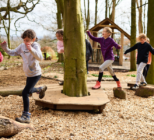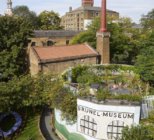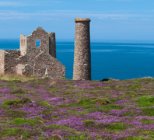Museums are unique platforms for communities to come together to learn new things and challenge existing ideas of who we are and what our place is in the world. They help us to understand our heritage and values, to interpret our present and to imagine our future.
Climate change and the environmental crisis we are experiencing will determine what that future looks like and how we resolve the inevitable social inequities and economic and political upheavals arising from these issues.
The decline of our natural environment is the biggest challenge of our times and it requires a shift in our approach to stewardship. A remarkable transformation is already taking place across the museums, galleries and heritage sector. A transformation which, although more subtle and understated than stereotypical eco-warrior activism and protest, is causing deep ripples of change in the cultural sector’s narrative surrounding climate change.
The Creative Climate Census is a pioneering study assessing attitudes towards environmental sustainability in the creative sector that reveals the wide reach of this shift. The study looked into several groups: combined arts, dance, literature, spoken word, museums and heritage, music, theatre and visual arts, and it revealed that the museums and heritage sector is deeply engaged on environmental action. They are more likely to have a dedicated green champion than any other respondent group and almost all museum respondents (94 per ecent) consider environmental sustainability to be relevant to their organisational vision and mission.
‘Birthplace of Global Warming’
One such organisation taking on this role in the context of past, present and future is Ironbridge Gorge Museum Trust, the education and heritage conservation charity that operates the 10 Ironbridge Gorge Museums in Shropshire. Ironbridge Gorge is known as the Birthplace of Industry due to its unique contribution to the UK’s Industrial Revolution in the 18th century, Ironbridge Gorge was designated as a World Heritage Site in 1986. This award brought with it the responsibility of ensuring that the Trust’s operations within this unique site not only conserved and cared for the historic and natural environment for future generations, but that the importance of this work is communicated to visitors and the local community. Some may argue that Ironbridge Gorge is not only the ‘Birthplace of Industry’, but also the ‘Birthplace of Global Warming’, due to the initiation of the commercial use of fossil fuels. As a result the Trust has been inspired to work with partners within the Gorge and has set the goal of becoming the world’s greenest inhabited World Heritage Site.
Anna Brennand, chief executive of the Trust takes the and said that as the operator of a major museum within the heart of the Ironbridge Gorge World Heritage Site her trustees, staff and volunteers are also passionate about the needs of our local environment as well as global climate change. “We have worked hard to reduce our carbon footprint, through a range of strategic and practical measures and we are proud to be Telford’s Flagship Fairtrade Employer,” she said. “The Trust will continue to work with partners within the World Heritage Site community and museum ecology to ensure that we all champion environmental best practice.”

As for how this translates into day-to-day action, as a Green Tourism Business Scheme Gold Award holder the Trust has introduced a range of measures including practical energy saving and waste avoidance, growing produce that is used within the historic houses at Blists Hill Victorian Town, community recycling projects and award-winning environmental education work with schools. The Trust also works closely with catering teams and event clients to develop environmental understanding and best practice.
Manchester Museum, part of the University of Manchester, is another example of best practice with a wide range of permanent and temporary exhibitions which encourage visitors to explore their attitudes and values about nature.
Nature and Me
One of their initiatives include the ‘Nature and Me’ project, a series of films of local people with a wide variety of connections to nature, and themed ‘Big Saturday’ events for families on a range of nature themes. 2016’s Climate Control was a six-month long series of exhibitions and events exploring what kind of future people hope for and how to make it a reality, including opportunities to rebuild a model Manchester. The museum is also organising a conference on climate change and museums in 2018 and is involved in international sustainability initiatives, including participating in United Nations climate dialogues and supporting the Tokyo Protocol work in advocating for science centres and museums role in supporting the achievement of the Sustainable Development Goals. Henry McGhie Head of Collections & Curator of Zoology, Manchester Museum, University of Manchester says: “Museums present a wonderful opportunity to not only connect people with the past, but to connect with the present and to shape our collective future.”
Also part of the University of Manchester, the Whitworth Gallery has a long-established environmental programme which extends across its activities, from building and park operations, procurement and transport to programming, exhibitions, learning and outreach. The building operates with no powered cooling having replaced air-conditioning with mechanical ventilation and implemented a range of passive measures during its recent green-oriented £15m renovation.
All gallery staff have committed to two days sustainability-specific work per year and the Whitworth is the only UK gallery to have created the dedicated posts of Cultural Park Keeper and Landscape and Sustainability Technician as part of its remit is to raise awareness on all things ‘green’. For Nicola Walker, Head of Collection Care & Access at the museum, it’s their collaborative approach to helping create a sustainable museums community that is the key: “Our work with Julie’s Bicycle and collaborations with other museum, heritage and educational institutions are vital to raising awareness of the importance of environmental sustainability and tackling climate change.”
Steps to Sustainability:
If your museum or heritage site or organisation is looking to starting out on climate change and environmental action, here are some first steps you can take:
- Start at the beginning: ask what climate change and environmental issues mean for your organisation on a specific and fundamental level, given its core purpose, stewardship and community role and key activities. Is it about protecting the natural environment of a site and engaging with the visitors who enjoy it? Making sure collections are protected against flood risk? Connecting collections and learning with environmental themes?
- Make sure you have some understanding of the environmental impacts you do have depending on the size, scale, nature and location of collections, heritage, buildings and sites etc. Also think about the areas of impact over which you have most control and influence. Julie’s Bicycle’s IG Tools, a free online carbon and calculator can help you do this.
- Start working on a plan to achieve these. Download the Museums’ Environmental Framework from the Julie’s Bicycle website. It’s a straightforward and practical guide to greening your museum from wherever you’re starting out.
- Reach out to other museums and heritage sites to see how you might be able to work together. Even small organisation can make big environmental impacts by taking a collaborative approach within the museums community, as in the case of the Lapworth Museum who organised and hosted a sustainability event for museums representatives last year.
- Work towards Creative Green Certification, the only environmental certification scheme designed specifically for the creative and cultural industries, run by Julie’s Bicycle. You’ll be able to access specialist training and learning workshops, good practice and learning from peers, marketing of your sustainability achievements and independent assessments of your environmental performance. Once you are on the road to sustainability, you can join a community of pioneering museums and heritage organisations to become recognised and supported in your commitment to performing your best environmental practice.
From museum development agencies to networks, campaigns and sector support organisations there are increasing opportunities for museums, galleries and heritage organisations to build understanding, access support and collaborate on climate change and environmental sustainability, for example:
- Tyne and Wear Archives and Museums’ project Make Carbon History, delivered through the Arts Council England-funded Museum Development North East Programme, resulting in 15 local museums reducing emissions by 18% and saving £56,000
- Museum Development North West work with the Carbon Literacy Project in Manchester on training, and Arup on the development of a checklist and guide for museums on building thermal performance
- Sustainable Exhibitions for Museums run a knowledge-sharing network for museum and gallery professionals working to improve the sustainability of exhibitions
- Fit for the Future Network, set up by the National Trust and Ashden Foundation, is a network of organisations from the heritage sector working together to become climate-friendly
- Happy Museum created a new guide, Discover and Share: Ways to Promote Positive Values in Arts and Cultural Settings is a valuable resource to support and enable public expressions of concern about social and environmental challenges. This guide draws on learning from a year-long collaboration between Manchester Museum and Common Cause Foundation, inspired by the work of the Happy Museum project
Joining the Charge
For museums and heritage organisations interested in joining the charge and taking environmental action, the first steps may seem daunting, especially for smaller organisations. Not everyone is in a position to fully overhaul their buildings and not everyone even has a building! But Claire Buckley, the Environmental Sustainability Director at Julie’s Bicycle who spearheaded last year’s pioneering Museums’ Environmental Framework, insists that not only can all museums take meaningful environmental action, but that they can do this in a way which speaks to and adds value to the stewardship and community role which is at their heart. “The key is to start by working out what climate change and environment means for an individual museum, given its size, shape, location, the nature of its collections, and the communities in which they are based,” she says. “And it will mean different things to different organisations: protecting collections, buildings and sites from flooding or coastal erosion; saving energy and money; investing in healthier, more sustainable technologies and materials; meeting funders’ environmental requirements; new opportunities to connect collections, learning and outreach with environmental themes and community building.”
Over the past 12 years, Julie’s Bicycle has built a quantitative and qualitative evidence base which shows that culture, climate and the environment are firmly bonded. We have now a creative community deeply engaged with environmental action, determined to use their full potential to help solve climate change. Julie’s Bicycle is also delivering Arts Council England Environmental Programme to the National Portfolio Organisations 2018-22.
If you want to get involved see our 7 Trends A Creative Climate Movement to find out ways to get started.
Key Findings
- Almost all museums and heritage organisations (94 per cent) consider environmental sustainability to be relevant to their organisational vision and mission.
- Additionally, 83 per cent or four in five think environmental sustainability will become more important over the next few years – by far the highest proportion of any respondent group
- 94 cent per cent of respondents say they have experienced benefits from their environmental actions. They were also the only group to identify capital development as one of their top three priority areas for investment of resources into environmental sustainability over the next three years.
- 65 per cent of respondents have a dedicated green team or green champion – the highest of any group and levels of day-to-day action such as measuring environmental impacts are relatively high.










